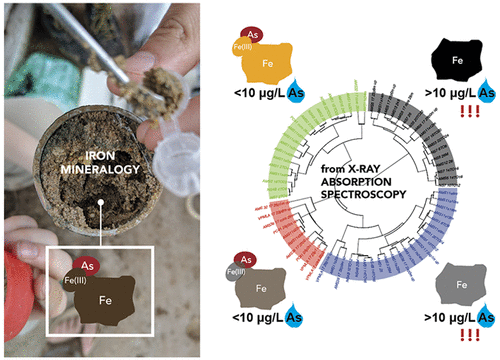当前位置:
X-MOL 学术
›
Environ. Sci. Technol. Lett.
›
论文详情
Our official English website, www.x-mol.net, welcomes your
feedback! (Note: you will need to create a separate account there.)
Aquifer-Scale Observations of Iron Redox Transformations in Arsenic-Impacted Environments to Predict Future Contamination
Environmental Science & Technology Letters ( IF 8.9 ) Pub Date : 2020-09-30 , DOI: 10.1021/acs.estlett.0c00672 Athena A Nghiem 1 , Yating Shen 2 , Mason Stahl 3 , Jing Sun 4 , Ezazul Haque 5 , Beck DeYoung 3 , Khue N Nguyen 6 , Tran Thi Mai 7 , Pham Thi Kim Trang 7 , Hung Viet Pham 7 , Brian Mailloux 8 , Charles F Harvey 9 , Alexander van Geen 6 , Benjamin C Bostick 6
Environmental Science & Technology Letters ( IF 8.9 ) Pub Date : 2020-09-30 , DOI: 10.1021/acs.estlett.0c00672 Athena A Nghiem 1 , Yating Shen 2 , Mason Stahl 3 , Jing Sun 4 , Ezazul Haque 5 , Beck DeYoung 3 , Khue N Nguyen 6 , Tran Thi Mai 7 , Pham Thi Kim Trang 7 , Hung Viet Pham 7 , Brian Mailloux 8 , Charles F Harvey 9 , Alexander van Geen 6 , Benjamin C Bostick 6
Affiliation

|
Iron oxides control the mobility of a host of contaminants in aquifer systems, and the microbial reduction of iron oxides in the subsurface is linked to high levels of arsenic in groundwater that affects greater than 150 million people globally. Paired observations of groundwater and solid-phase aquifer composition are critical to understand spatial and temporal trends in contamination and effectively manage changing water resources, yet field-representative mineralogical data are sparse across redox gradients relevant to arsenic contamination. We characterize iron mineralogy using X-ray absorption spectroscopy across a natural gradient of groundwater arsenic contamination in Vietnam. Hierarchical cluster analysis classifies sediments into meaningful groups delineating weathering and redox changes, diagnostic of depositional history, in this first direct characterization of redox transformations in the field. Notably, these groupings reveal a signature of iron minerals undergoing active reduction before the onset of arsenic contamination in groundwater. Pleistocene sediments undergoing postdepositional reduction may be more extensive than previously recognized due to previous misclassification. By upscaling to similar environments in South and Southeast Asia via multinomial logistic regression modeling, we show that active iron reduction, and therefore susceptibility to future arsenic contamination, is more widely distributed in presumably pristine aquifers than anticipated.
中文翻译:

在受砷影响的环境中对铁氧化还原转变进行含水层规模的观测以预测未来的污染
氧化铁控制着含水层系统中许多污染物的流动性,而地下氧化铁的微生物还原与地下水中的高砷含量有关,影响着全球超过 1.5 亿人。对地下水和固相含水层成分的配对观测对于了解污染的空间和时间趋势并有效管理不断变化的水资源至关重要,但与砷污染相关的氧化还原梯度中具有代表性的现场矿物学数据很少。我们使用 X 射线吸收光谱法对越南地下水砷污染的自然梯度进行铁矿物学表征。分层聚类分析将沉积物分类为有意义的组,描述风化和氧化还原变化,诊断沉积历史,这是现场氧化还原转变的首次直接表征。值得注意的是,这些分组揭示了铁矿物在地下水砷污染发生之前经历主动还原的特征。由于之前的错误分类,更新世沉积物经历沉积后还原的范围可能比之前认识的更广泛。通过多项逻辑回归模型升级到南亚和东南亚的类似环境,我们发现活跃的铁还原以及因此对未来砷污染的敏感性在可能的原始含水层中的分布比预期更广泛。
更新日期:2020-12-08
中文翻译:

在受砷影响的环境中对铁氧化还原转变进行含水层规模的观测以预测未来的污染
氧化铁控制着含水层系统中许多污染物的流动性,而地下氧化铁的微生物还原与地下水中的高砷含量有关,影响着全球超过 1.5 亿人。对地下水和固相含水层成分的配对观测对于了解污染的空间和时间趋势并有效管理不断变化的水资源至关重要,但与砷污染相关的氧化还原梯度中具有代表性的现场矿物学数据很少。我们使用 X 射线吸收光谱法对越南地下水砷污染的自然梯度进行铁矿物学表征。分层聚类分析将沉积物分类为有意义的组,描述风化和氧化还原变化,诊断沉积历史,这是现场氧化还原转变的首次直接表征。值得注意的是,这些分组揭示了铁矿物在地下水砷污染发生之前经历主动还原的特征。由于之前的错误分类,更新世沉积物经历沉积后还原的范围可能比之前认识的更广泛。通过多项逻辑回归模型升级到南亚和东南亚的类似环境,我们发现活跃的铁还原以及因此对未来砷污染的敏感性在可能的原始含水层中的分布比预期更广泛。









































 京公网安备 11010802027423号
京公网安备 11010802027423号